In one of the most intriguing tactical battles since the start of the 2020/21 campaign, Arsenal hosted Manchester City at the Emirates Stadium in this EFL Cup quarter-final. Both teams struggled to score goals this season, but the game was not a boring one. Instead, it was a five-goal thriller, ending with a 4-1 victory for the guests.
In the previous three clashes between Mikel Arteta’s Arsenal and Pep Guardiola’s Manchester City, we saw their tactics counter each other. How about this one? What are the details and how they made the differences? This tactical analysis will reveal them all to show how the Citizens won the game.
Line-ups
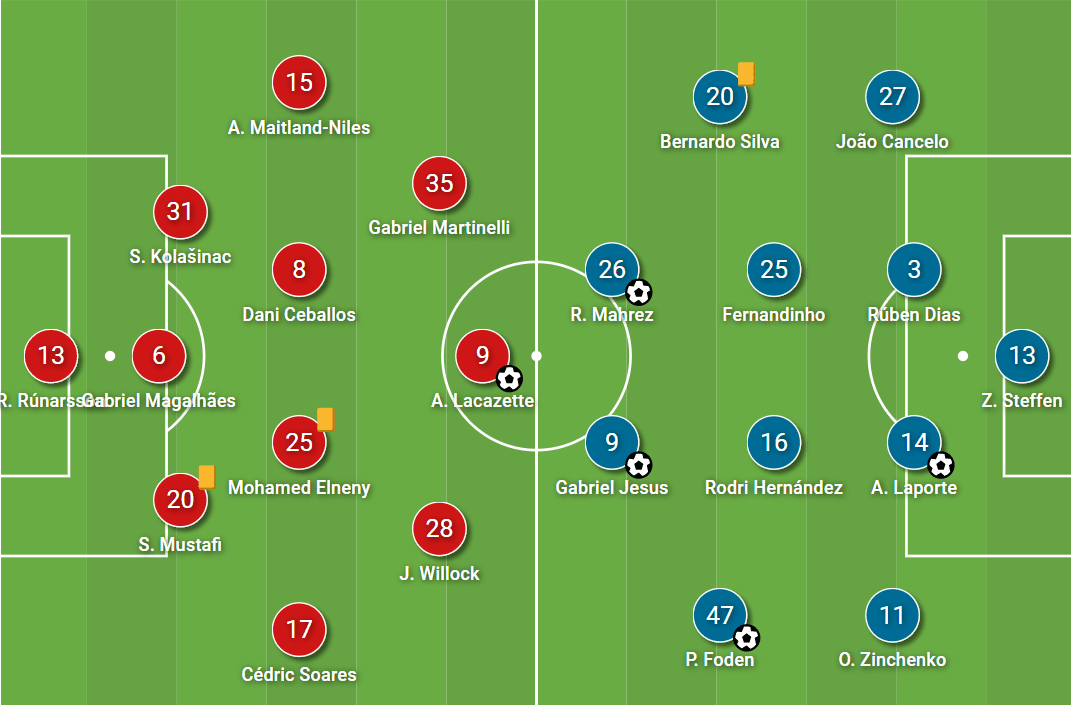
Arsenal reverted to a back three after the approach of playing with four defenders did not succeed in the Premier League recently. There were some rotations in this midweek cup tie, as goalkeeper Bernd Leno was replaced by Rúnar Rúnarsson. Players who did not have a lot of playing time in the first team this season, including Joe Willock, Gabriel Martinelli, and Sead Kolašinac all started. However, we noted the Gunners shifted to a back four quickly to solve the structural issues.
Pep played a strong team but rested Kevin De Bruyne and Benjamin Mendy. Nathan Aké was unfit, so Rúben Dias started with Aymeric Laporte again. Oleksandr Zinchenko also had his chance to play at the left-back position. The fluid front players should not be constrained by positions, so a 4-4-2 was just an inaccurate formation on paper. City were a lot more than that.
City demolished Arsenal by a central overload
Starting with a back five, it seemed Arsenal’s game plan was pretty similar to the FA Cup victory five months ago. In that game, the striker – Alexandre Lacazette stuck close to the holding midfielder of City, while the wingers pressed very well, with the collaboration of the midfielders travelling up and down, meant that the build-up at Wembley was extremely difficult.
However, Pep would not allow the same scenarios to happen again. There are many changes in this City team this season that gives them more tools to face different opponents. One big change was the use of double-pivot, a very “Juanma Lillo Style” way of playing. Starting Fernandinho and Rodrigo Hernández at the midfield helps City to play out from the back very well.
Instead of congesting both at the centre, the duo tended to stay in two vertical zones to offer layers in a 3-1 shape. It increased the difficulties for Lacazette to shadow one while pressing the other. The below image shows how Lacazette’s initial position was good, keeping Rodri under his shadow.
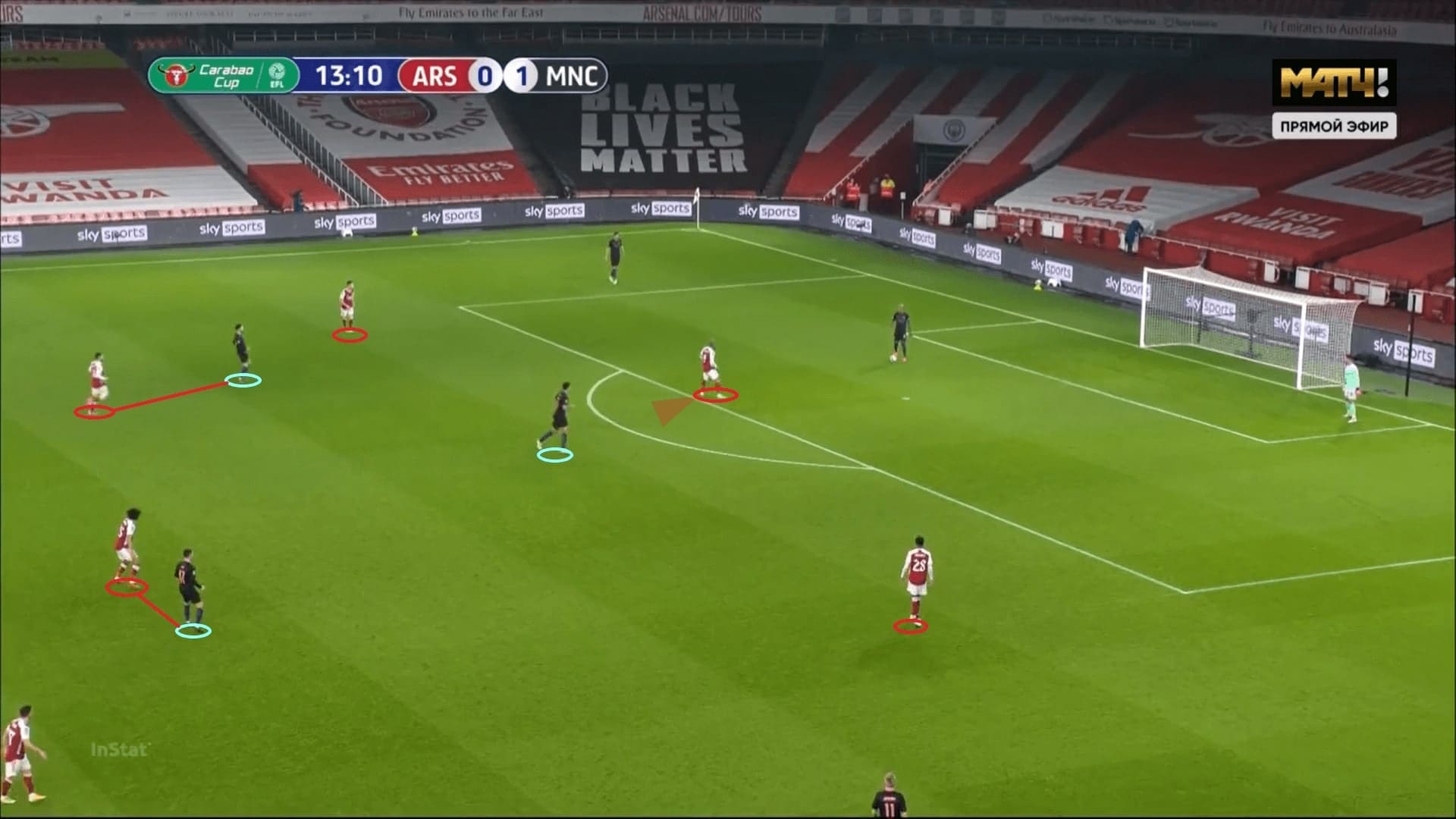
Another part that City did well was the manipulation of the second line, as we saw the different players entering the centre to control the behaviours of Arsenal midfielders. For example, even when including Lacazette, the Citizens had a 6 v 5 numerical superiority at the centre of the pitch. Since Arsenal were defending narrowly at the centre, the wide spaces were also opened for ball progression.
Meanwhile, credit should go to Gabriel Jesus and Riyad Mahrez who were alert to provide the offensive heights and constrain the defenders. The overload in the midfield was successfully created because of these two players.
The width must be provided and the wide players should stay away from the centre-backs unless they are going to receive the ball. This is vital to manipulate the positionings of the Arsenal wing-backs so the Gunners could not compress spaces in City’s defensive third or at the centre.
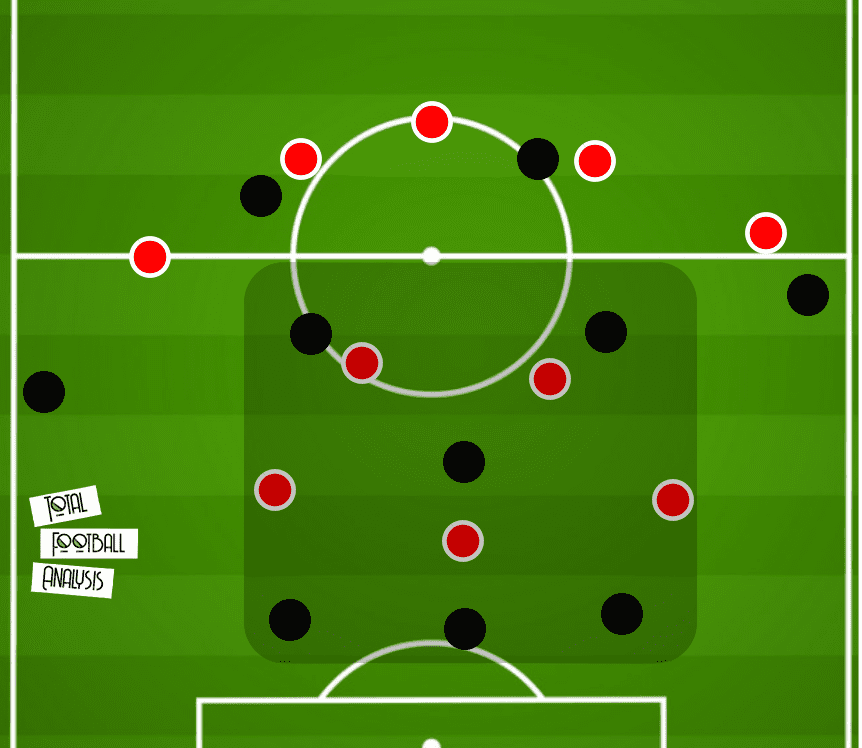
Here is the following scenario from the first example. We saw Fernandinho play to Zack Steffen, which triggered the press by Lacazette. Thus, Rodri was not under the Frenchman striker’s shadow anymore. Mohamed Elneny read this loophole and immediately covered Rodri at the expense of leaving Phil Foden, and Joe Willock saw this and so he moved towards Foden.
Now Steffen was cleared about what to do next, as Laporte was the remaining free option around. Arsenal lacked numbers to defend in this case as the City left-back kept the right wing-back of Arsenal away from the pressuring zone. As a result, a 4 v 3 numerical superiority and a free player was created in this zone area to break the press.
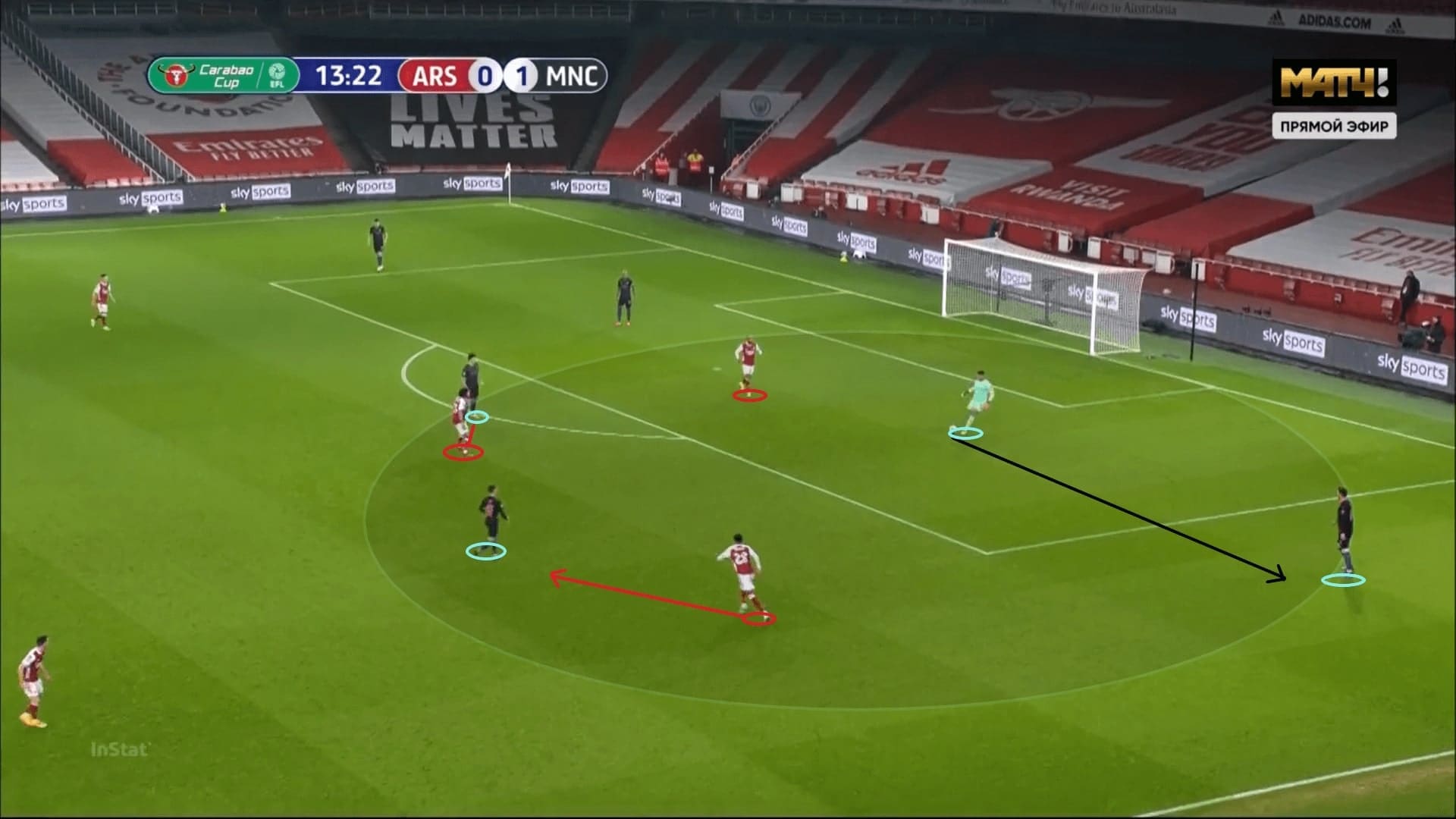
As mentioned, the likes of Foden and Bernardo Silva, or even João Cancelo, could enter the centre to manipulate the second line. When the Arsenal midfielders oriented themselves towards the ball because of the limited pressure from the first line, the space behind them increased.
Under those circumstances, Foden did very well to do half-turns with his body while staying between Elneny and Willock. This way, he could receive the vertical passes, turn within one-touch, and face the backline directly – City would reach the final third in these cases.
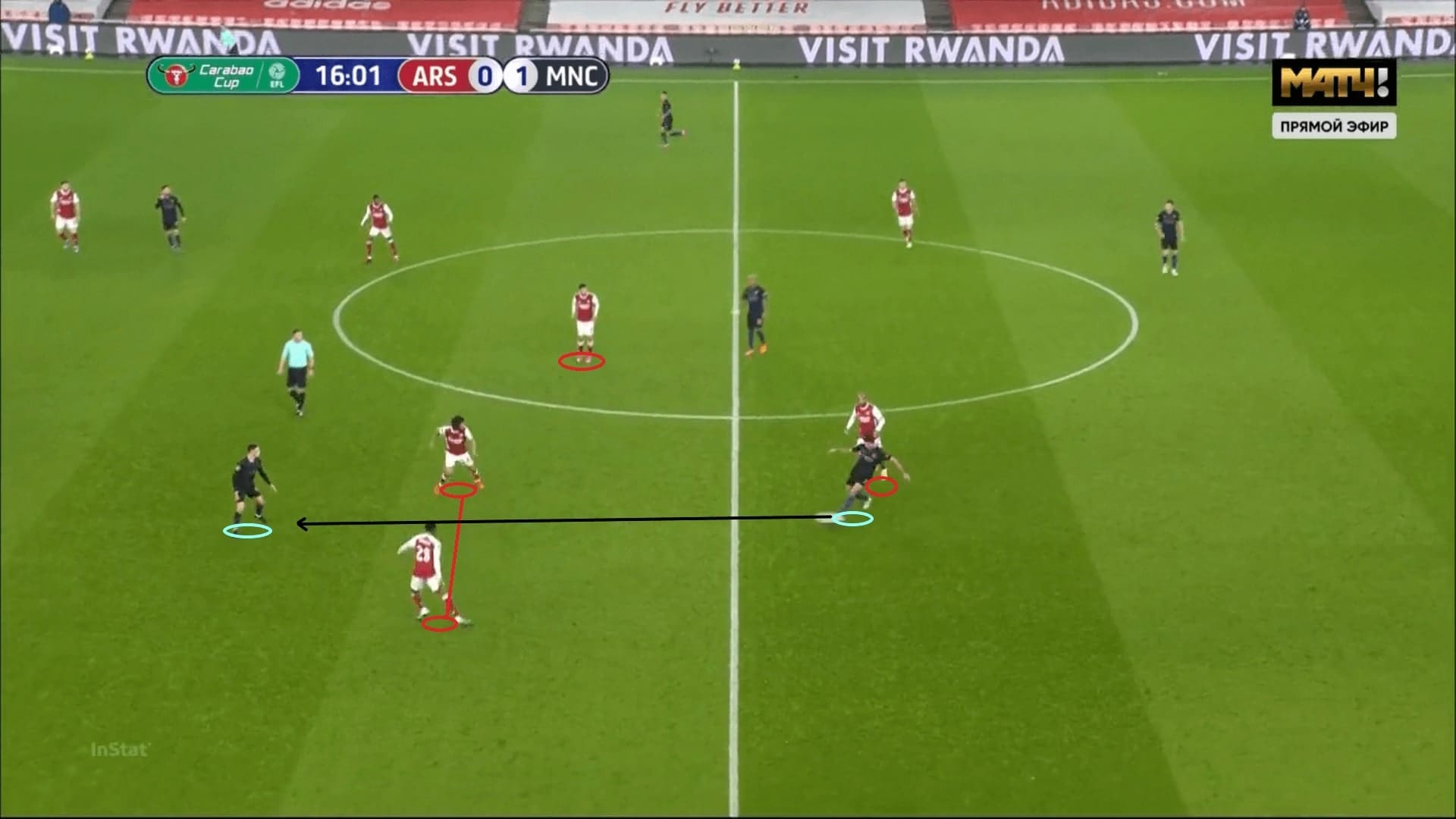
This is another example of the manipulation of the second line. City fully capitalise on the numerical “+1” superiority in the centre, constantly placing players behind the Arsenal midfield to keep them away from the ball. If they have done so, more space and time were created in the build-up areas.
Here, Elneny was dragged deeper because of Foden and Mahrez’s behaviours to drop between the lines. Consequently, spaces in the midfield were opened for Rodri, who exploited the blindside of the striker and show up as a passing option for Fernandinho. This game was very different from the one in the FA Cup as City played one more midfielder, which was difficult for Lacazette to keep his eyes both Rodri and Fernandinho.
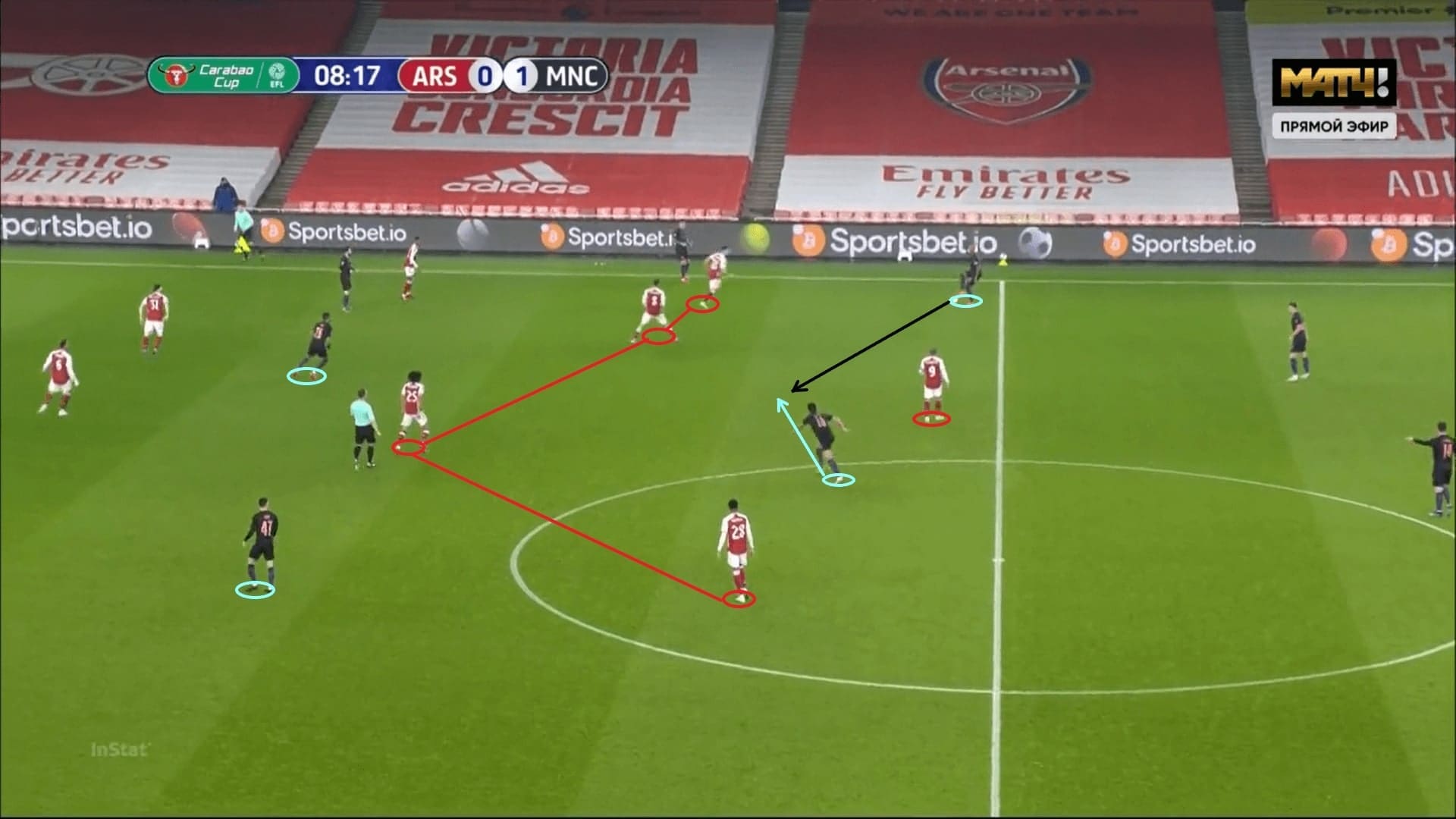
When Foden dropped, it was quite possible to take the opposition midfielder with him. This situation could be attributed to the height-providers’ contributions, for example, Jesus who kept Shkodran Mustafi in position. When Arsenal pushed the first line to press or closer to the centre-backs, City could use the overload on the midfielder to develop the attack.
As shown in this example, Foden’s dropping movement attracted the marking of Elneny, who retreated to cover the 20-year-old youngster. As a result, Fernandinho was free without any Arsenal players around, so Zinchenko could play the ball into the centre.
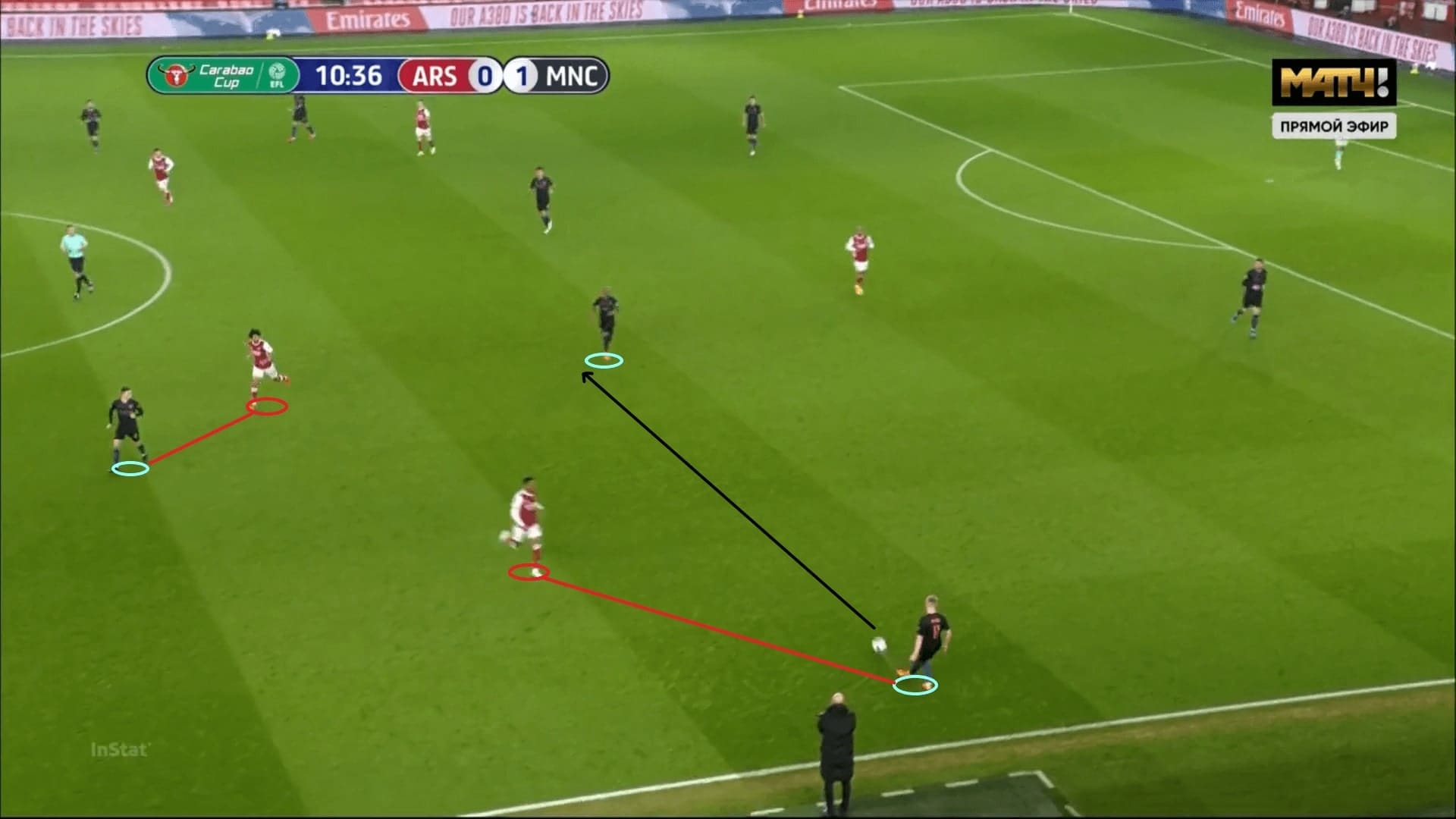
Apart from manipulation of the second line, using Martinelli’s position to interpret the free spaces was also a key theme of the build-up. One particular issue for Arsenal was the defensive efforts of the wingers since they were not curving the runs enough when pressing outside-in. Therefore the passing lanes to wide zones were left opened, the flanks had no protection when the wingers pressed. The wing-backs were staying deep in position with the backline. This was also the beginning point of the Jesus goal.
Here shows how City utilised numerical superiority to play out from the back again. This time, Silva was part of the personnel to drop from the midfielder’s blindside – Dani Ceballos found it difficult to track Portuguese international’s movement. A very simple third-man play could bypass the pressure, finding Cancelo at the touchline. The City right-back was left very free since Martinelli pushed very high to press the centre-back.
This was the weak spot of Arsenal when they oriented the front three to press the 3-1 shape of City, or committing the winger to press a centre-back without the curve runs.
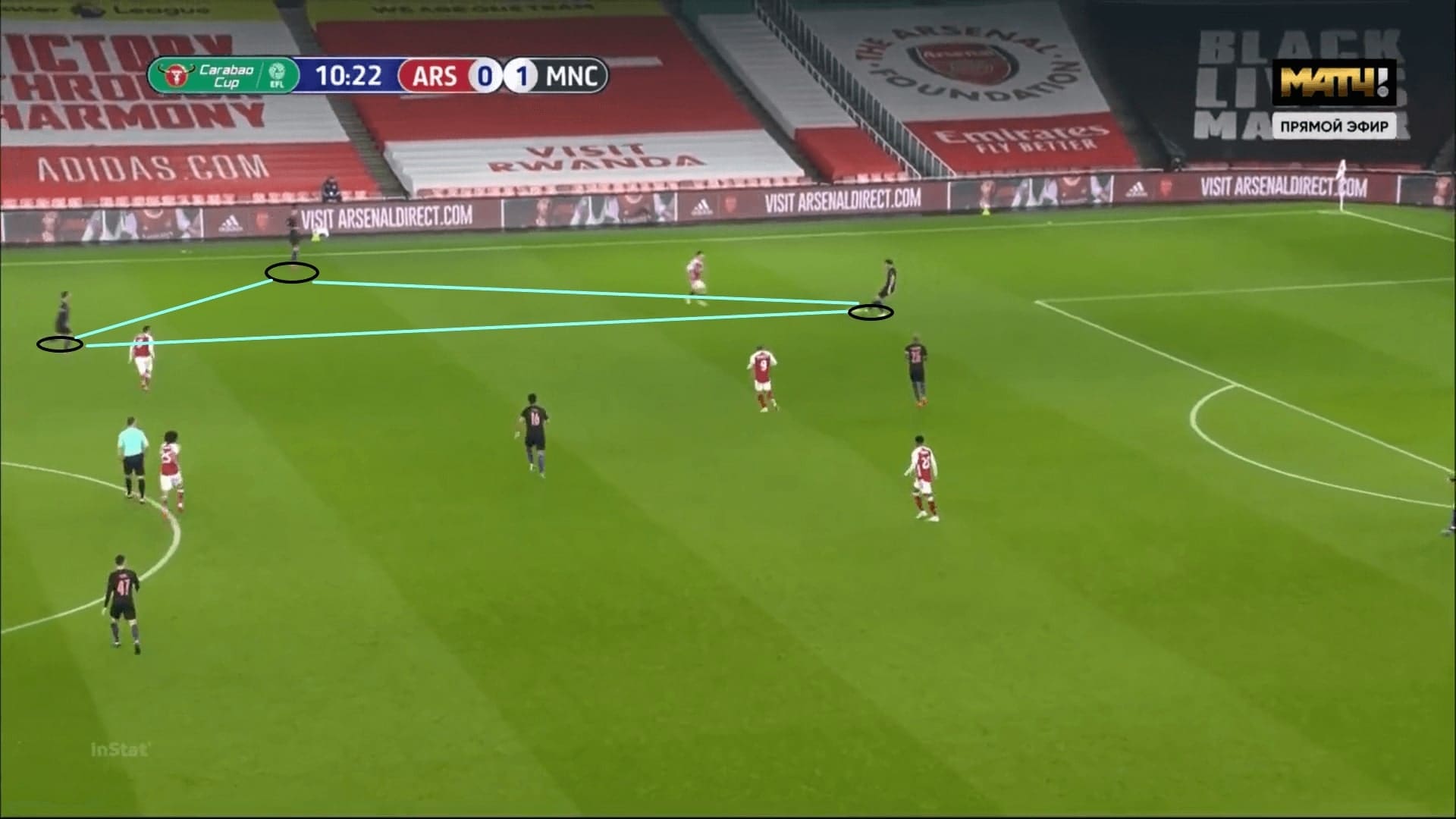
As mentioned in the above analysis, Cancelo also behaved as an inverted full-back to enter spaces at the centre. When Martinelli oriented himself to the right-back, he would also enter the central zone as framed in the below picture.
Consequently, the RCB-RW passing lane was opened. Dias easily found the widest player at the Arsenal backline as Martinelli stuck to Cancelo at the centre.
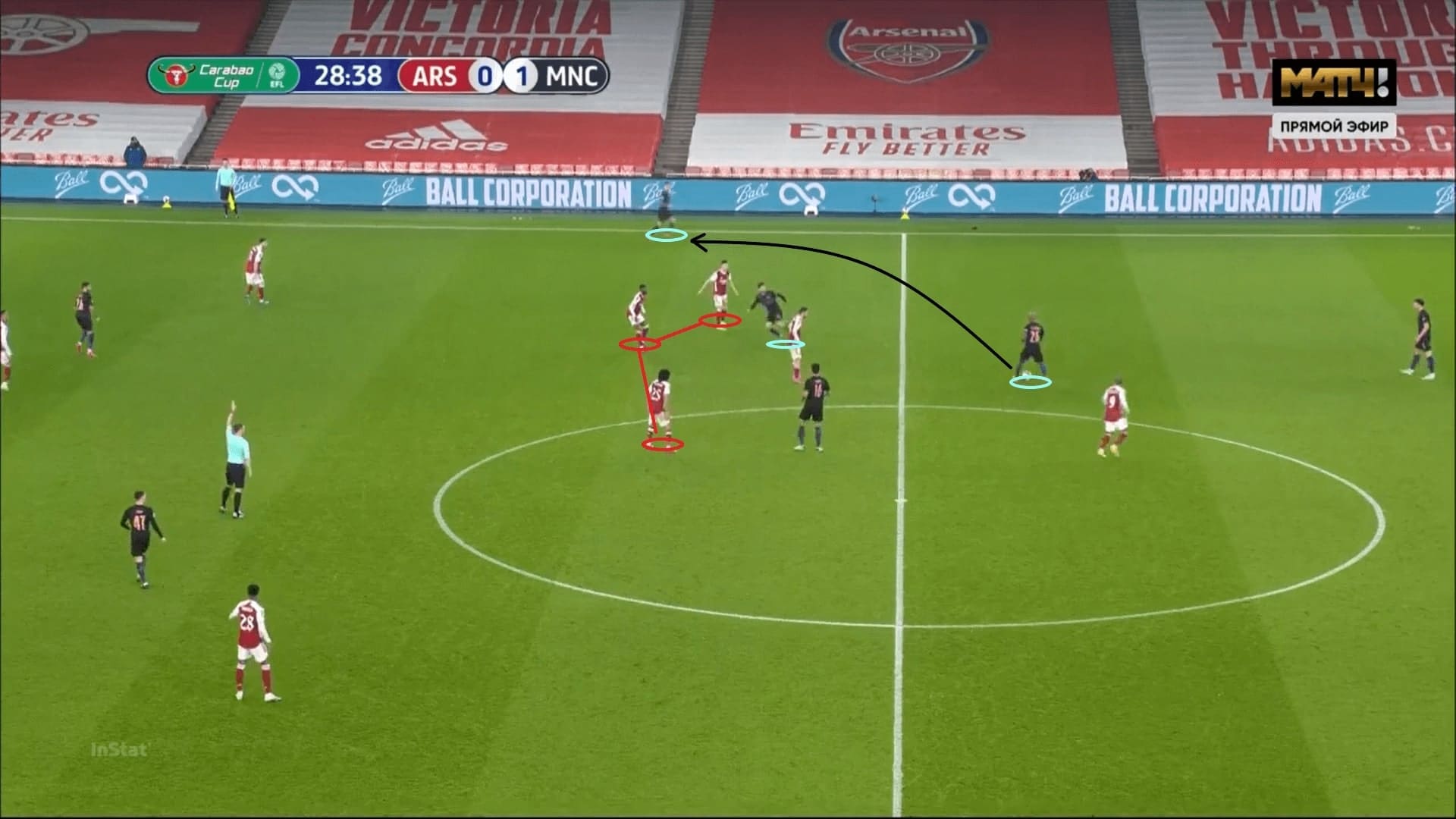
Arteta tweaked, things were better
Since they conceded a goal very early in the game, Arsenal had to change something, or else Pep’s men would extend the lead easily. Despite being criticised widely, Arteta did a wise change by instructing Ainsley Maitland-Niles to play as a midfielder during the press and midblock. Now, the formation was a 4-3-3 – Maitland-Niles, Elneny, and Ceballos forming the midfield trio. It was only when defending deep in the penalty box that Maitland-Niles would revert to the left wing-back position.
“…after that (the goal) I think we were the better team for the next 25 minutes.” – Arteta
This change helped Arsenal to take the initiative in open plays, and Arteta is right, they were the better side in some moments of the game.
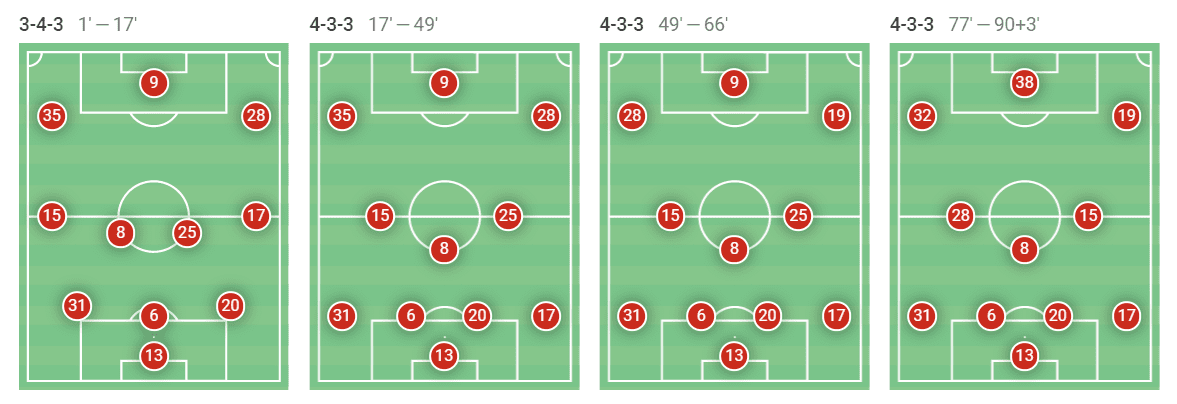
Placing the left wing-back into the midfield suggested there was an extra midfielder at the centre of the pitch now. Before this, City possessed the numerical superiority in the zone, but after that, the “+1” advantage was nullified. Now Arsenal had greater freedom and flexibility to press high up on the pitch.
As shown below, the midfield trio stayed more compact at the centre. Even when the front three were attached to the backline of City, the Gunners had enough numbers to defend spaces behind the first line. They also gained more control in attacking the right half-spaces of the Citizens and blocking this channel also cut the inward passing lane when the ball was passed to the right-back.
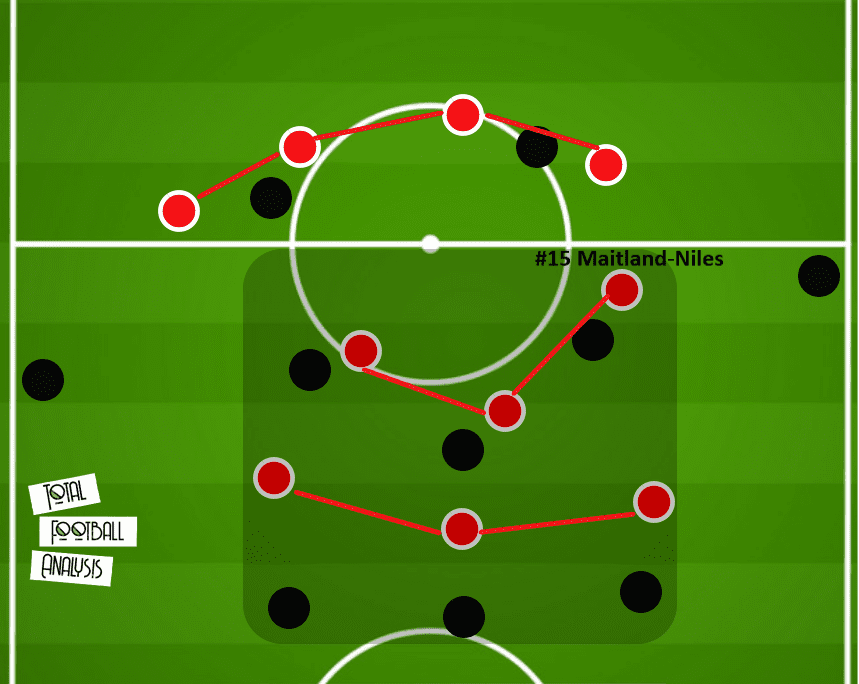
Compared to earlier scenarios in which Arsenal pressed a goal kick, Elneny was now leaving Foden free and the defence collapsed, so the Gunners now had enough players to defend high. The obvious difference was the positionings of the midfielders, where even if Lacazette went to press Steffen, Ceballos immediately covered Rodri. Behind Ceballos, there was no longer a numerical advantage for City, as the equality was reached by Maitland-Niles marking Silva.
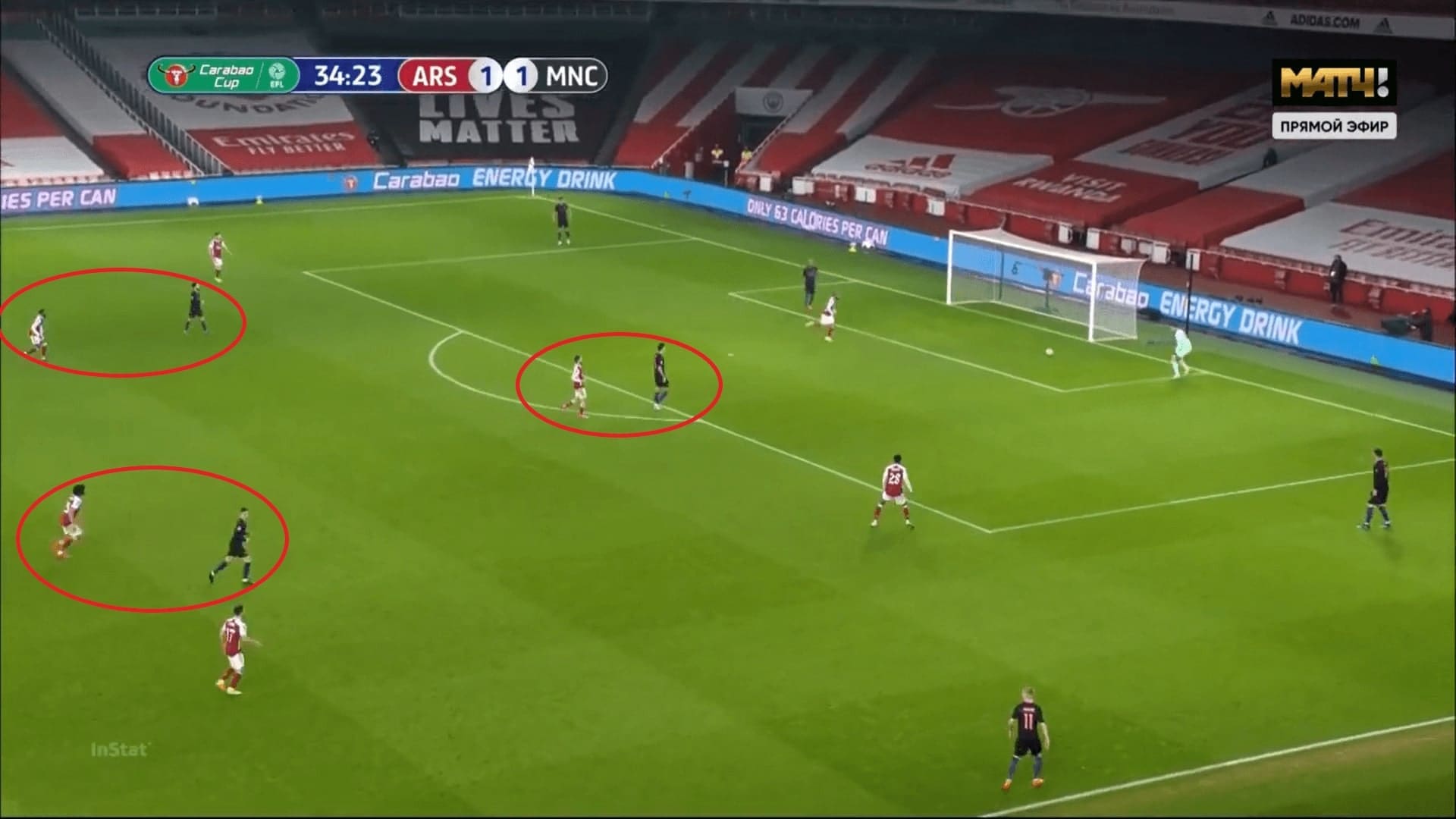
Another scenario a few minutes later than the above one. The passing sequence of City was the exact same with the previous example: Fernandinho – Steffen – Laporte. However, this time Arsenal were well-prepared to press high, committing the wing-back to the City third and compressed spaces. This time, if Laporte played to Zinchenko, they were fallen into the pressing trap as there was no way out for the left-back. The solution of the Citizens was to play long, either diagonally to the other flank or passing into space behind the Gunners midfield. However, neither Jesus nor Mahrez was good enough to dominate the battles in the air – City carried less threat in this stage of the game.
In fact, Arsenal found the equaliser because of this shift too. The goal from Lacazette could be attributed to the ball recovery of Maitland-Niles at the centre of the pitch.
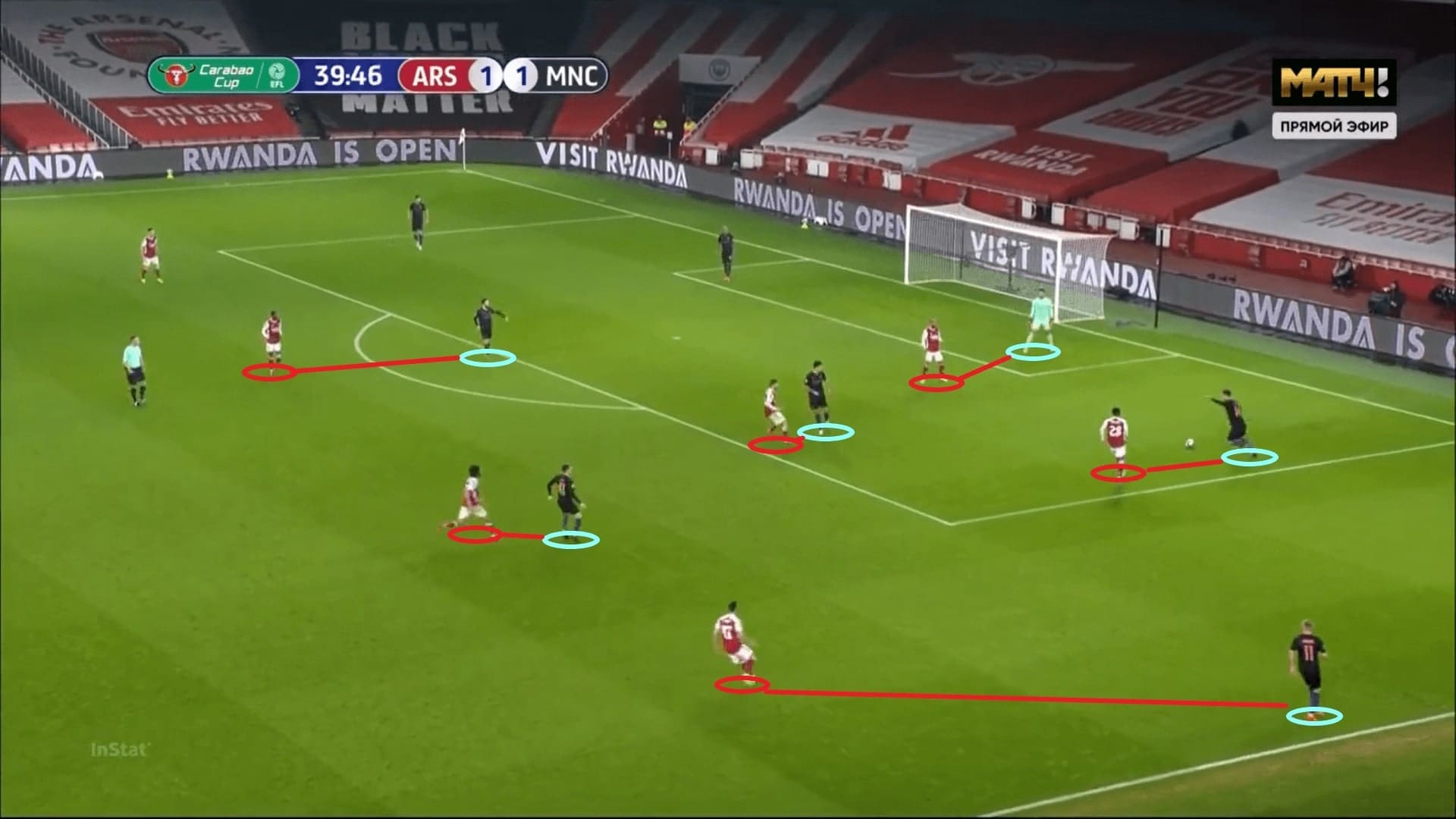
Successful moves to help City regained control
After Arteta shifted the team into a back four, they played better, and it was down to Pep and his coaching staff to react again. In the locker room, a few important instructions were told to the players to help City to regain the battle at the midfield. These tweaks of Pep worked quite well as City regained the dominant position of the game again.
Strategically, Arsenal moved Maitland-Niles’ position and played a 4-3-3. So how to counter this point was the key to success. Against a zonally defended Gunners, the tactic was to escape from Maitland-Niles’ zone or overload his area. The behaviours were similar to those in the first half – manipulation of the midfield line.
The 3-1 build-up shape did not change. The change was Silva’s role, who was ordered to play further centrally. Specifically, he would stay in the gap of Ceballos and Elneny so as to free Foden in the half-spaces. The Portuguese international would roam his position and support the ball often by providing himself as an option around. With Silva, City could generate an extra option near the ball, or the close proximity of players made quick combinations and third-man plays happened. Furthermore, staying between the Arsenal midfield duo means Silva could counter-act against their movements as soon as possible.
Regarding Maitland-Niles, City capitalised on the limited horizontal coverage of the 4-3-3 system to overload the 23-year-old English international. This was done by Cancelo staying out wide and dropping Mahrez from the height position often. This created a 2 v 1 overload as framed below.
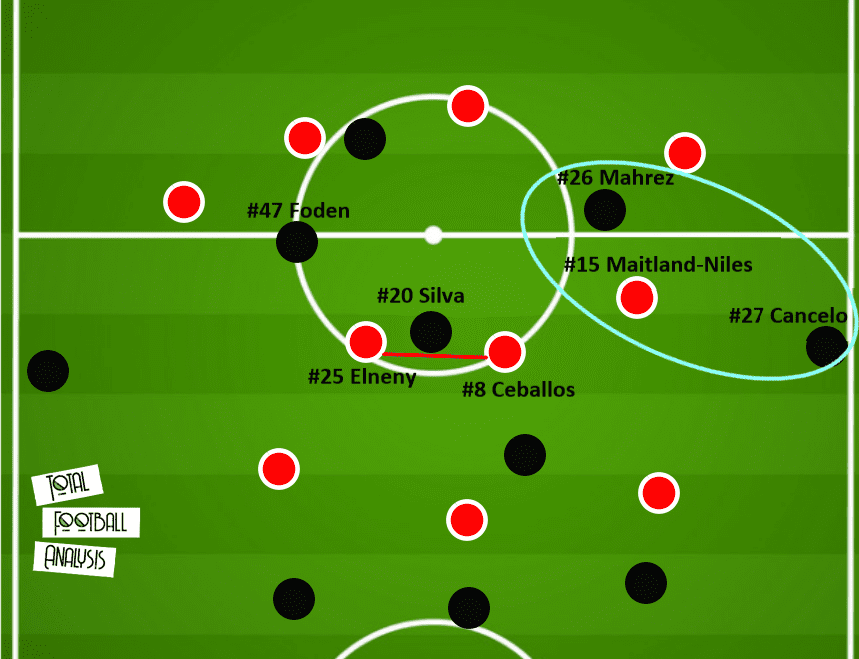
This was the scenario before the Mahrez free-kick goal. You could see Silva positioning himself between Elneny and Ceballos, staying away from Maitland-Niles’ zone. Not only was a passing triangle was created, but City also overloaded the duo in a 3 v 2 scenario with Rodri.
So, when Elneny pressed Rodri, the Arsenal midfielders were torn apart. It was impossible for Ceballos to tightly mark anyone, unless he gave up Silva or Foden. Given the distance of pressure was too large, Rodri pinpoints a vertical pass to find Silva, who won a free-kick in a dangerous area (valuing 0.20 xG).
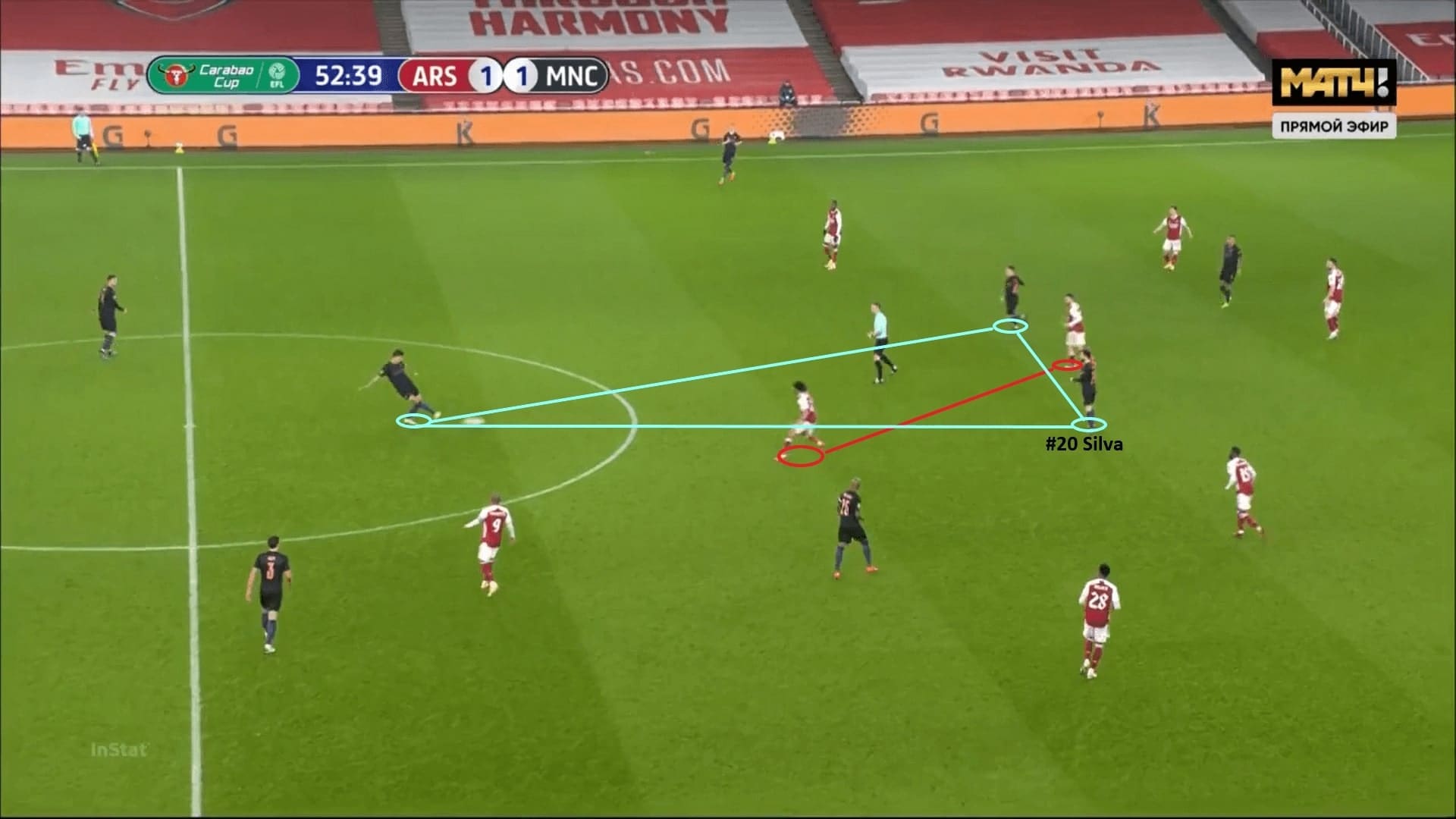
The image below was a mix of the mentioned changes. Firstly, as framed on the right, Mahrez slightly dropped from the backline to attach Maitland-Niles away from the midfield. This ensured spaces were available in the centre.
Secondly, Silva stayed between Elneny and Ceballos. Arsenal tried to nullify the “+1” advantage by committing the winger at the far-side to close the half-spaces. However, the drawback was leaving wide space open, where Zinchenko could be found by a lofted diagonal pass.
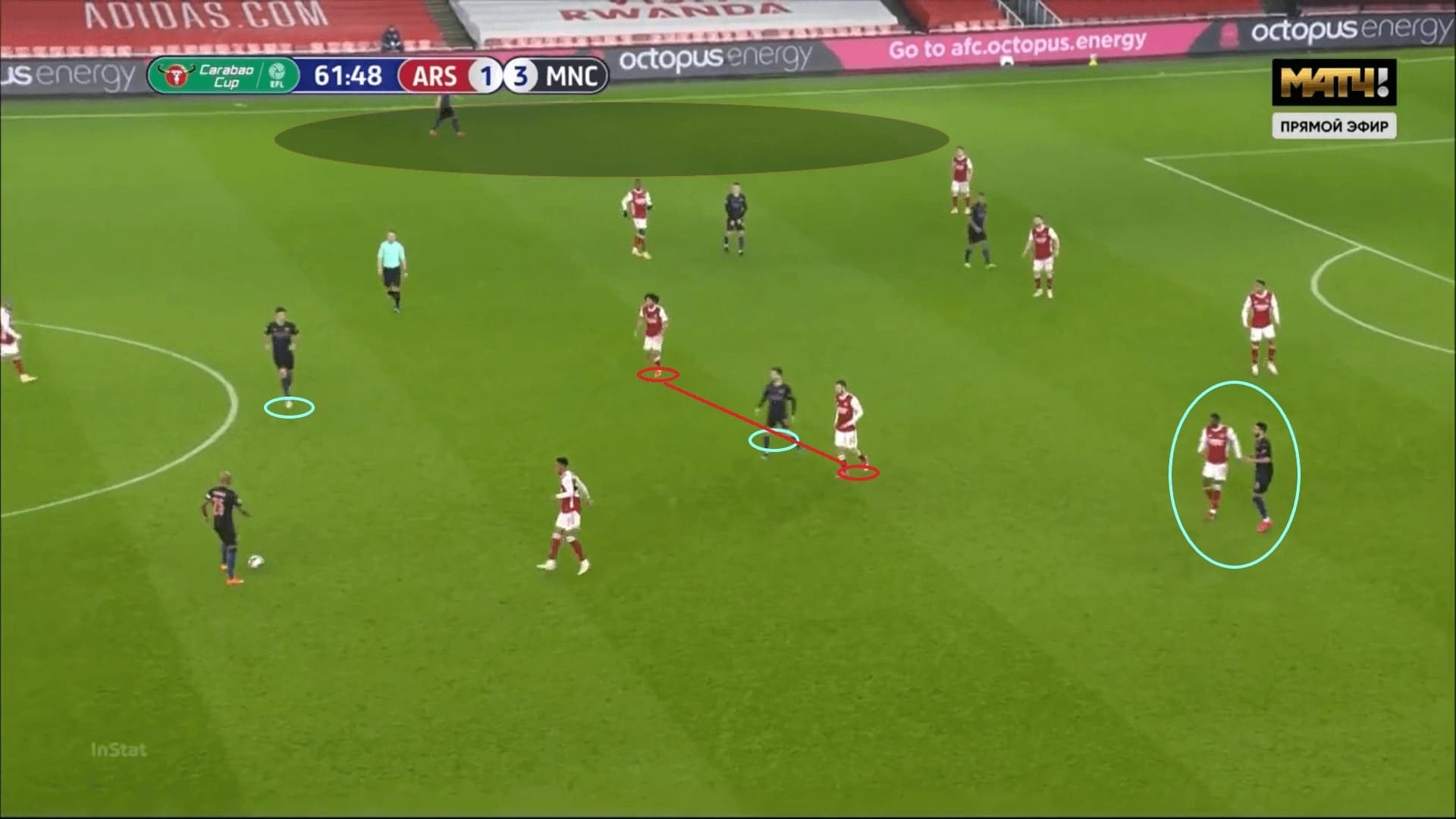
When attacking out wide, City were quick to move the ball. This tempo was vital to the offensive rhythm, or else they would be trapped near the sidelines and it would be difficult to get out. The movements of Silva have helped the team to progress the ball into advanced areas.
In the scenario below, Silva once again exploited the gap between Ceballos and Elneny. More importantly, Ceballos intended to defend spaces close to zone 16 as the right-back was taken out of position. With a simple double-movement, Silva moved from Elneny’s blindside to offer an option for Zinchenko, who was about to be trapped at the touchline. Then, this clever exploitation of space allowed Silva to operate nearer to the goal.
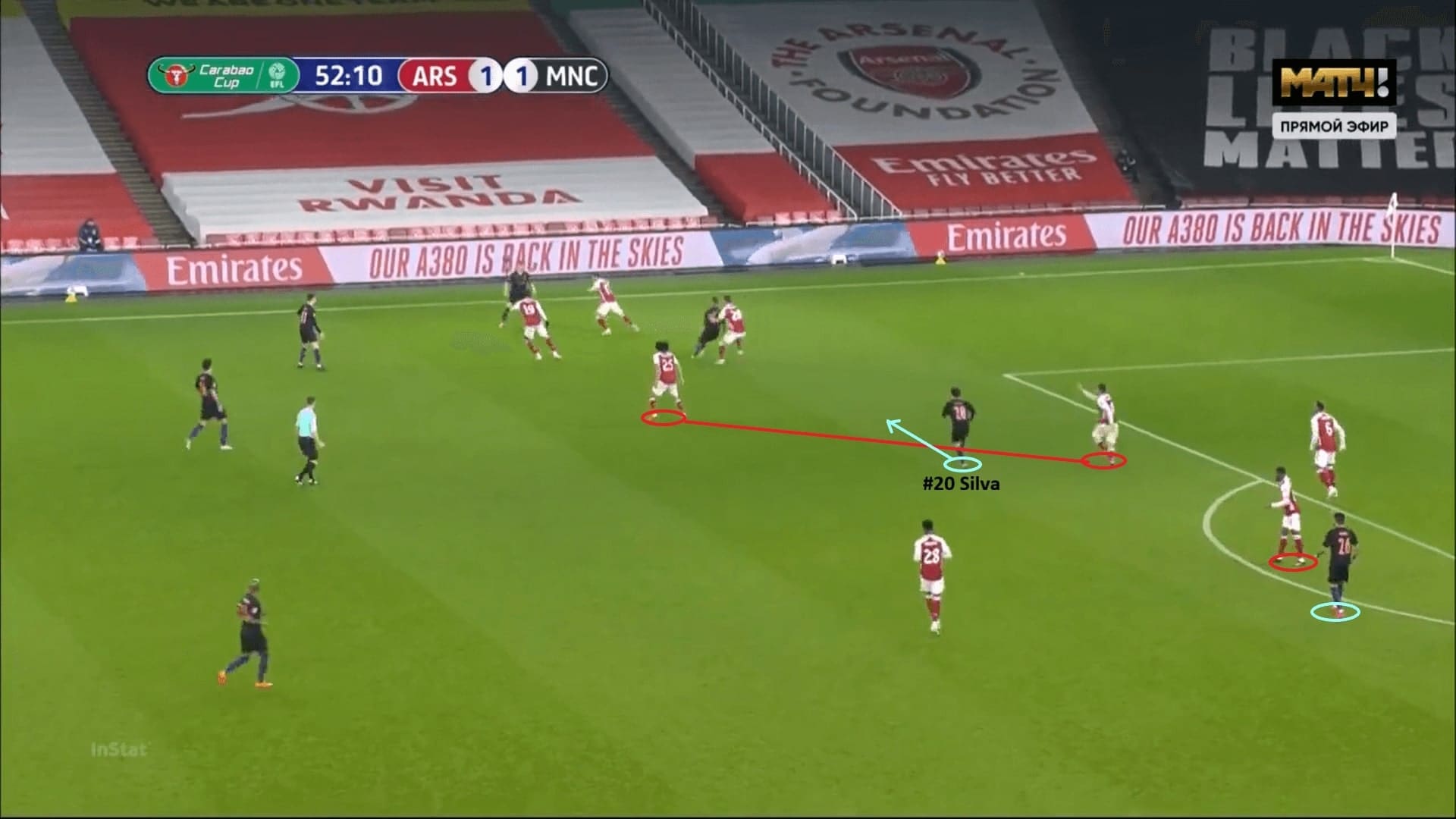
The remaining two examples are demonstrating how City countered the change of Maitland-Niles’ role. Instead of inverting into the half-spaces as he did in the first half, the right-back now stayed closer to the touchline while helping the centre-back more often. He received the ball right beside Arteta below.
All the actions of City depended on the reaction of Maitland-Niles – who came out to press Cancelo this time. This forced the rest of the midfield to shift towards this flank, facing the touchline. The solution was provided as Silva continued to exploit the gap between Elneny and Ceballos. After a simple one-two with Fernandinho to attack the space behind Maitland-Niles, Silva moved smartly at the blindside of Ceballos to receive the pass from Cancelo. This broke the press and City were going to the final third.
Out of the frame, Mahrez has done his job to keep the left-back in position. This was also important or else the space to receive the return ball from Fernandinho would be compressed.
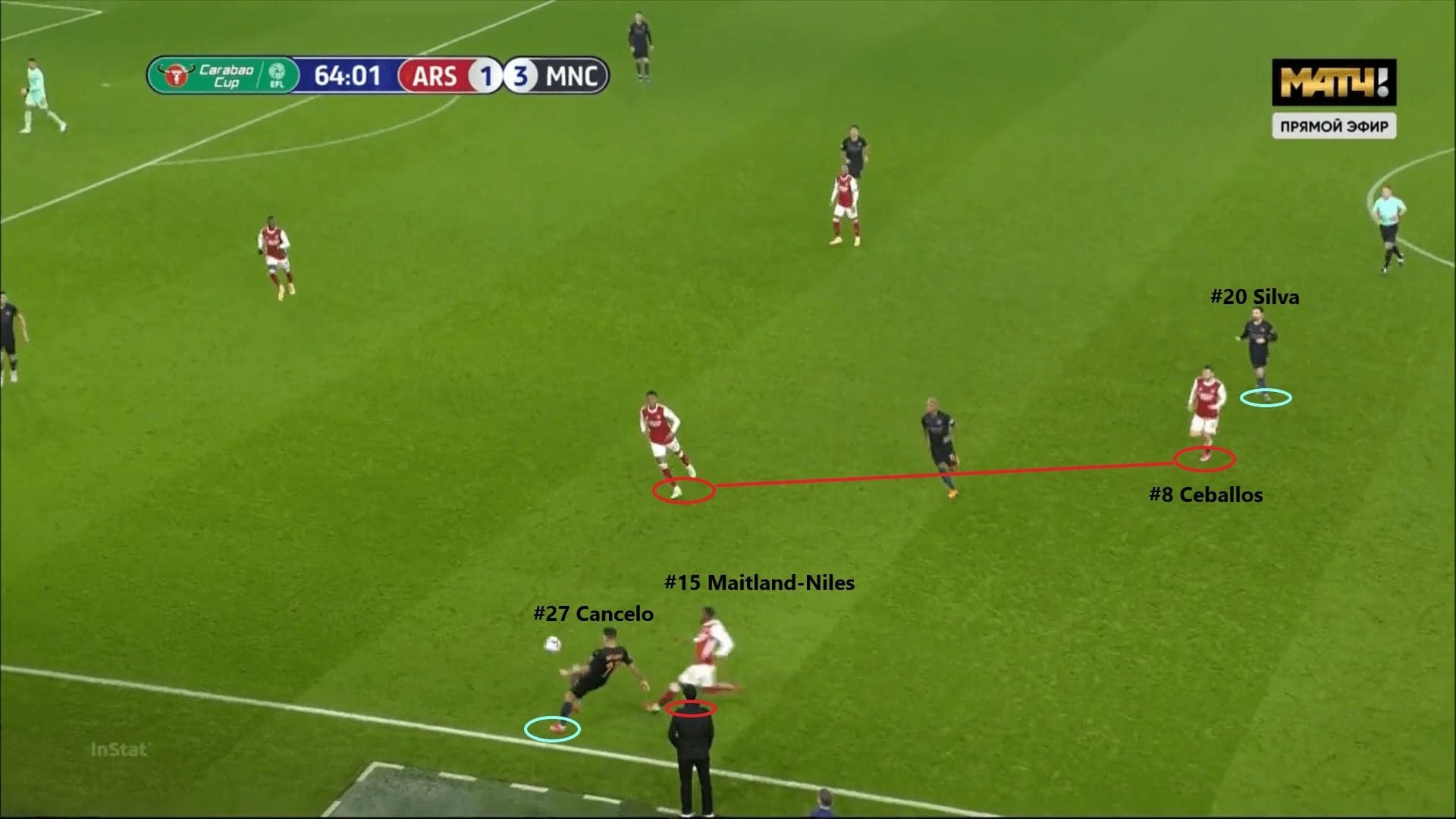
A variation was Maitland-Niles staying in position because of City’s manipulation. Here, Foden dropped deep, performing the role of Mahrez as suggested above. Considering the Arsenal front three were attached to the back three of City, the left-winger (Emile Smith Role) was far away from Cancelo.
Consequently, Cancelo had free space to carry the ball forward. This forced Arsenal to commit the left-back to press him, but it only resulted in more opened spaces behind Kolašinac and Mahrez attacked those spaces again.
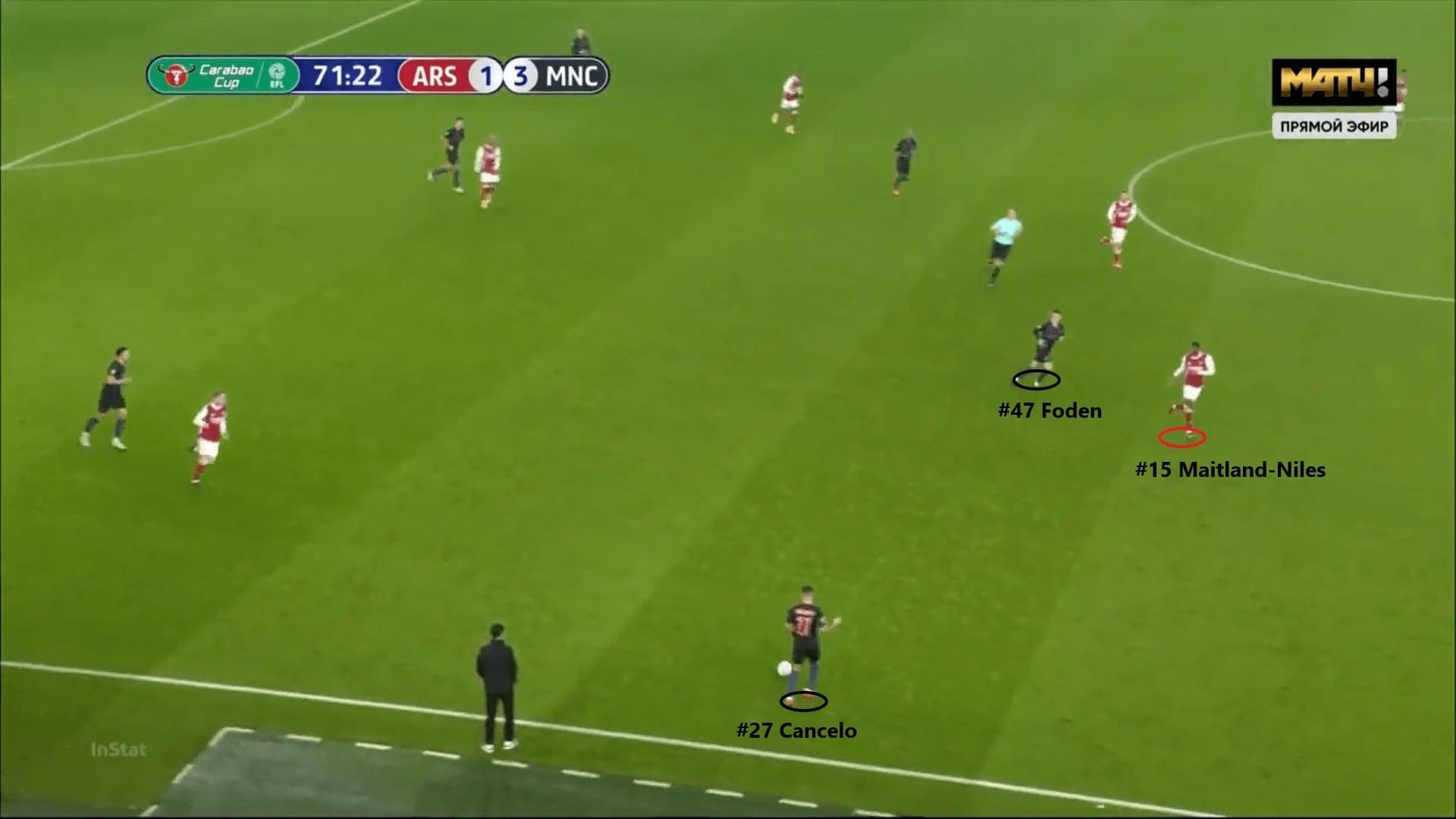
Pressing traps and repeated stories
The last part of the analysis dissects how City’s set the pressing trap cleverly in Arsenal’s build-up phase. In fact, this strategy was not a new innovation as we have seen this already in their Premier League clash back in October.
We want to indicate two key points in this phase. Firstly, the white zone indicates central areas occupied by the Arsenal midfielders, who may or may not be tightly marked by the City midfield duo. However, no matter how tight the marking was, neither Ceballos nor Elneny possessed the ability to carry the ball forward. Arsenal lacked verticality in this zone to advance quickly, hitting spaces behind Fernandinho and Rodri. Consequently, their attacks were forced sideways, and this was a huge limitation for Arsenal.
The dark zone indicated the pressing trap of at flanks, where they had a numerical superiority to regain possession. You could expect seeing the right-back, right-winger, and the right midfielder of a 4-2-4 formation to dominate this area.
Initially, City began with the shadowing efforts of the two-man first line to prevent Arsenal from entering the white zone. Then, they would be forcing the ball to the centre-backs by angling and curving the pressing run. In an Arsenal attack that was developed on the left, Gabriel Magalhães was the man to receive the pass and play forward. City intentionally opened the vertical passing lanes for the centre-back to play into the dark zone (e.g., half-spaces), then aggressively attack the closed-body receiver.
If Magalhães played the ball to the left-back, there would have been no problems. The right-winger shall angle his run to force a vertical pass from Kolašinac, no matter who the receiver was, and Cancelo shall tightly stick at his back and press the closed-body receiver.
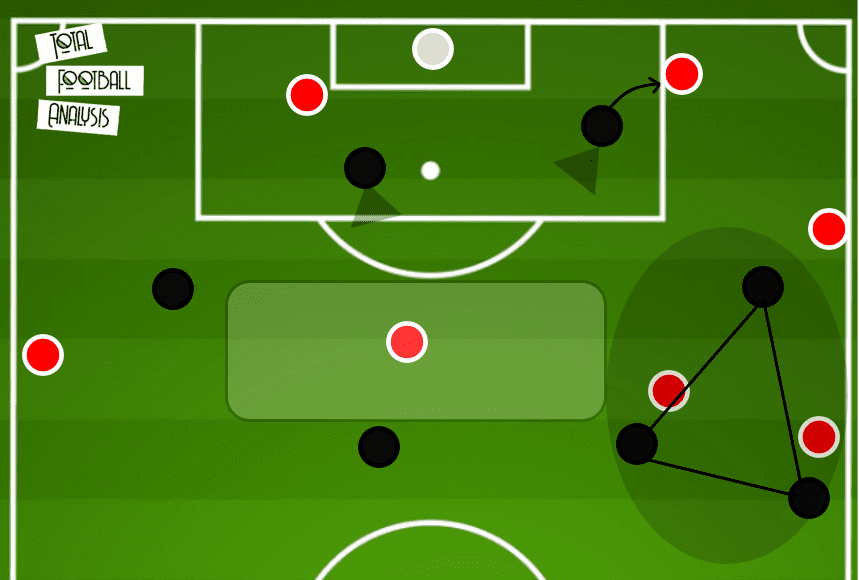
In this image, you can note the high pressing of City, with Jesus excellently shadowing Elneny, while Mahrez stayed in position even though Ceballos left the white zone (priority is to protect spaces). Even with Willock dropping behind Fernandinho, Ceballos would not be able to find him because of the extremely narrow passing channel – too much of a risk to take.
One thing that Arsenal have changed from the Premier League clash was the build-up shape, it was more often a 3-1 shape as one of the pivots would drop to the outside of the press. However, the executions were suboptimal as the Gunners could not break the lines for progression.
Here, the back three all stayed in the same horizontal zone, which means even if Ceballos found Magalhães, the pass did not facilitate any progression. Instead, it would be better if the left centre-back could receive the pass at the indicated position, which was behind Mahrez’s layer. A reasonable explanation of this relative positioning was the limited angle of a right-footed passer at this place, maybe Granit Xhaka could have done this job better.
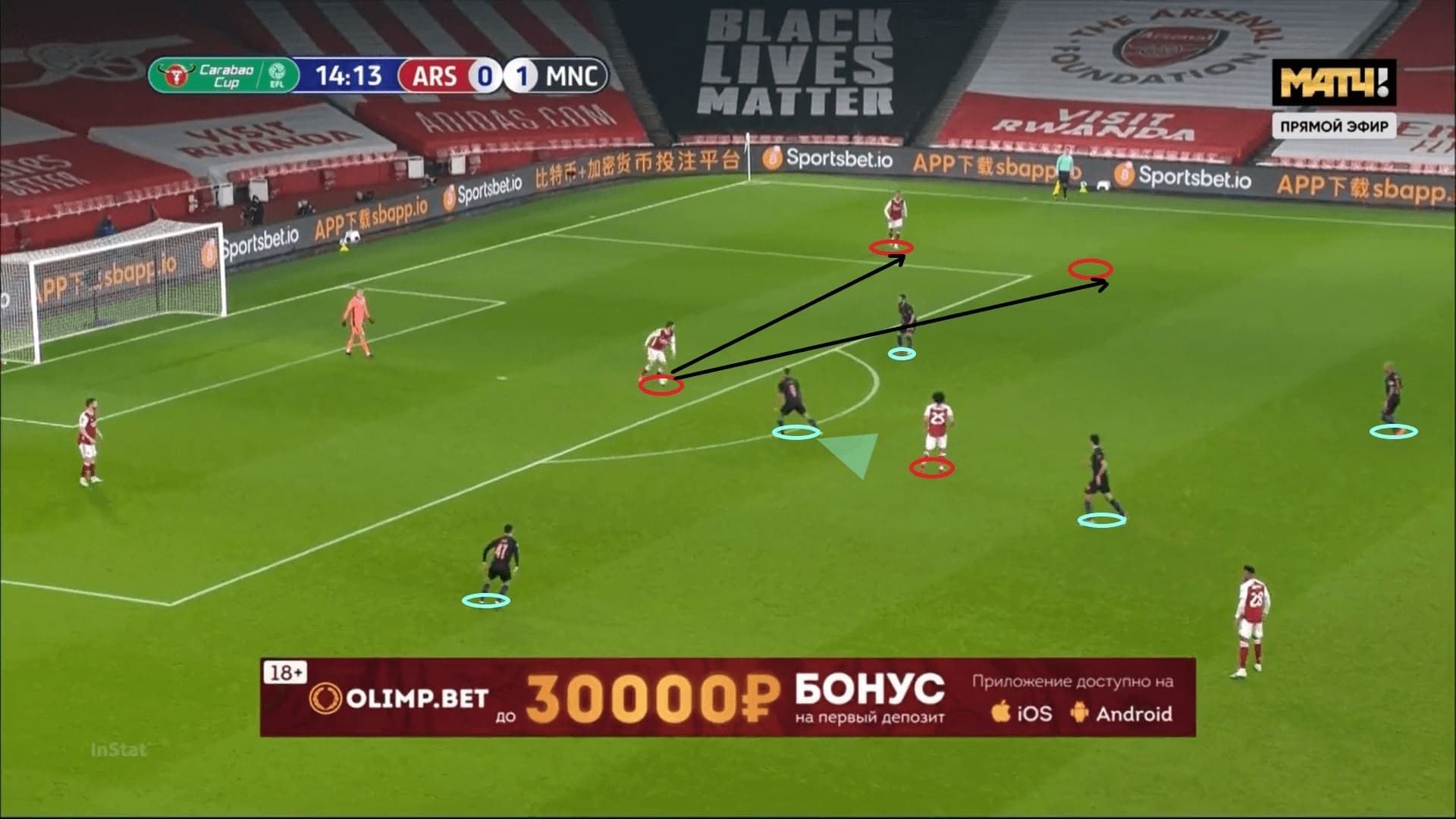
So this was how Arsenal were guided into a pressing trap. Ceballos passed to Magalhães, which facilitates zero progression. City squeeze the wide spaces exactly as we have mentioned in the above tactic board. The vertical passing lane was narrowed down as much as possible to force a difficult pass from Magalhães, who tried to find the dropping player in the same channel.
Given the narrower angle of the pass and the pressure around, the pass was poorly executed and Fernandinho read it early. It was an easy interception and the turnover occurred near the Arsenal third – a counter-attack opportunity for City.
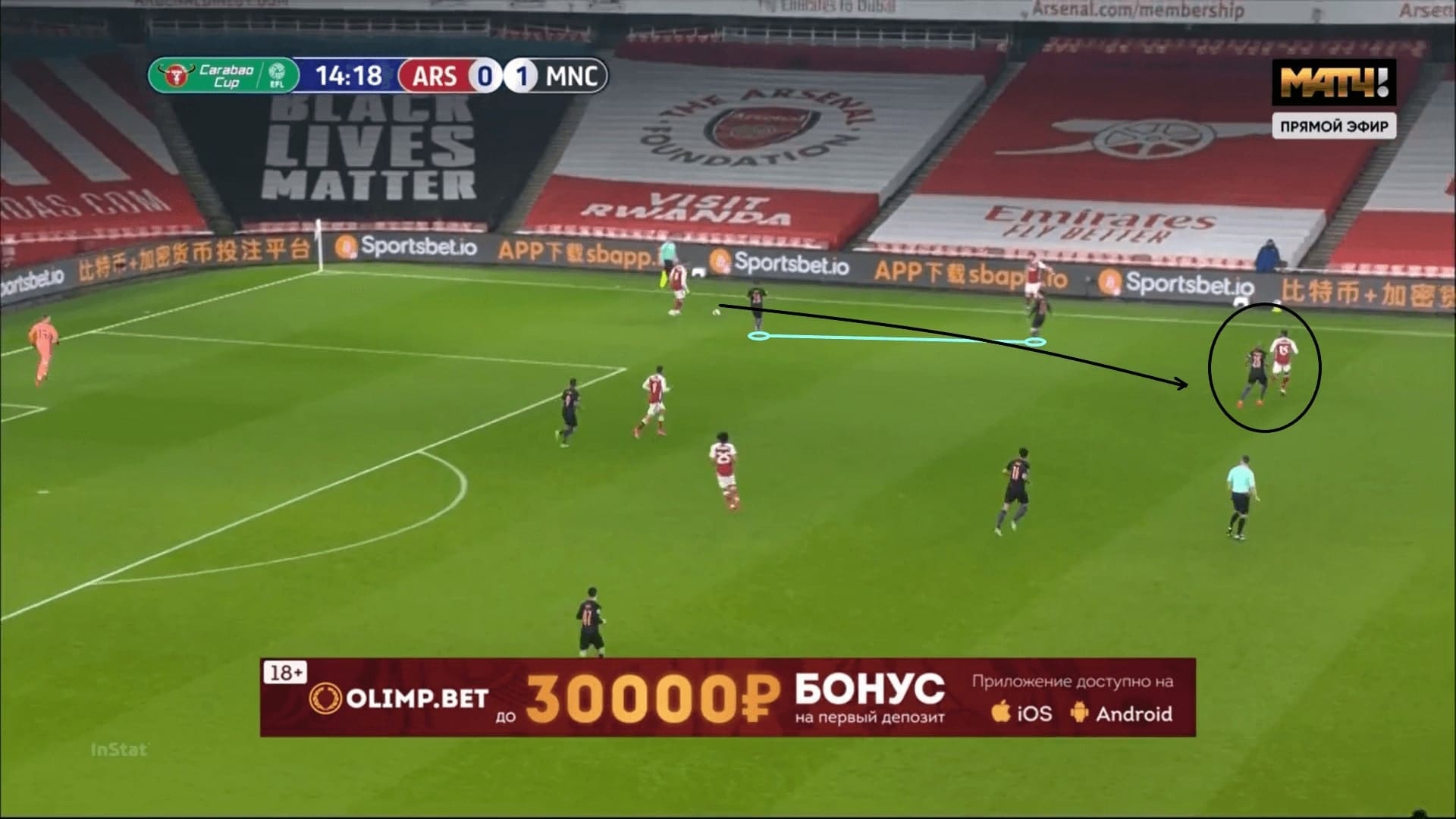
As the game developed, Arsenal might have found their solution. The first one was dropping Lacazette from the striker position to offer a passing option behind Rodri and Fernandinho. The below image shows it.
However, they were restricted to follow the inside-outside-inside pattern as the inability to develop the attack from the white zone as explained. Only if the distancing between Mustafi and Cédric Soares had been large enough, could they then have avoided the press from City’s left-winger. To cope with Soares, the City left-back would step up but it was too late to press the former Southampton man. Simply finding Lacazette means the Gunners have broken the high press already.
This pattern did not work every time given the aforementioned restrictions. Also, when Lacazette dropped too deep, he gained Rodri or Fernandinho’s attention and was unable to free himself as an option. Furthermore, the wide combination of Arsenal needed more efforts on the training ground, as more synchronised actions were needed to speed up the tempo and seize the momentum to exploit spaces.
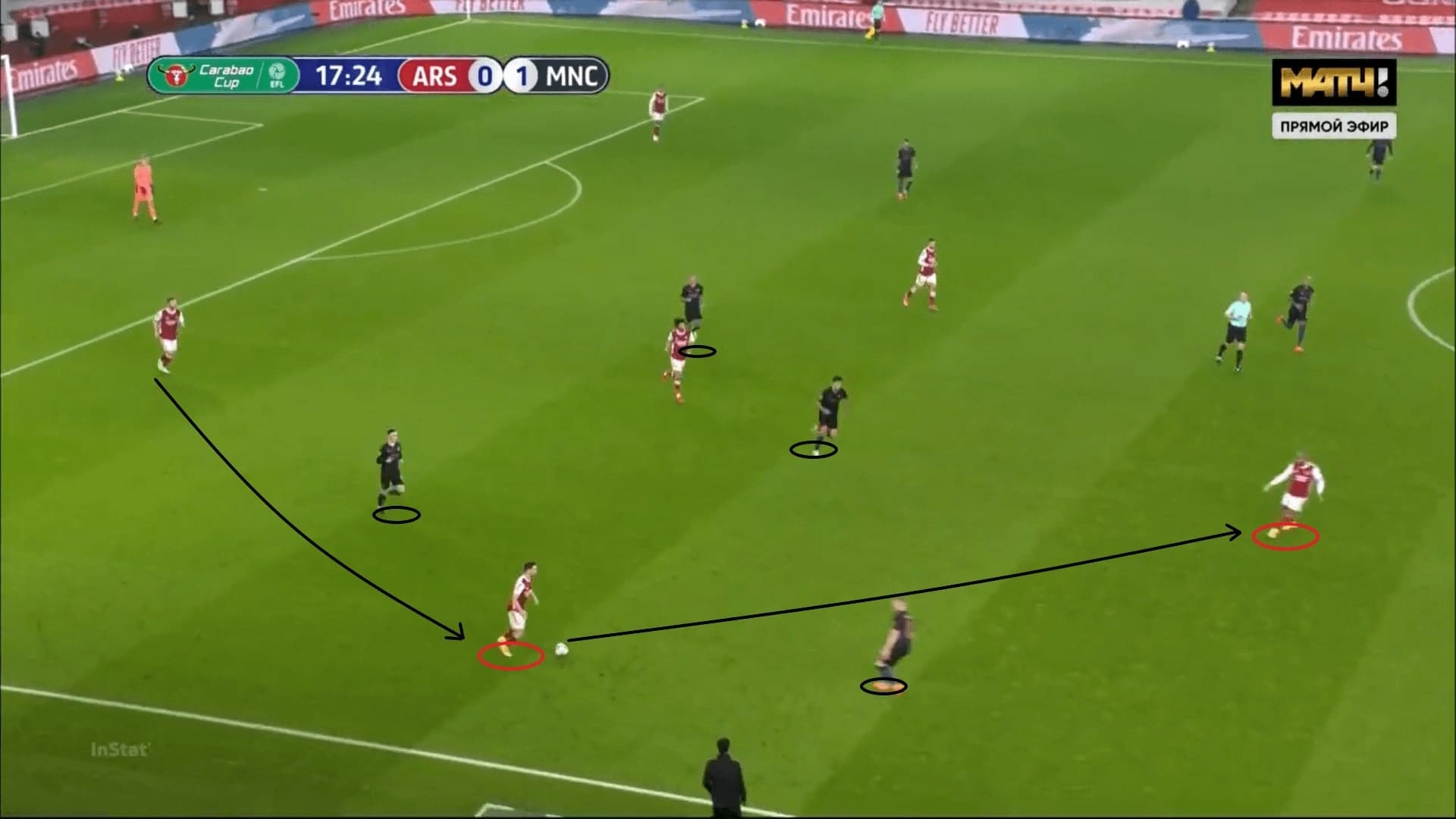
The tactic board below shows a solution that we have seen more often in the second half. It was dropping Ceballos as the left centre-back or Magalhães to carry the ball into this position. This was better since whenever Kolašinac also moved behind the first layer of City defence simultaneously, that meant a progression was made if the left centre-back passed.
The benefit of this shape was dragging the winger out of position. When the City right-winger engaged the left centre-back, Kolašinac’s zone would be free from the marking and he could enjoy further space to carry the ball forward.
Yet the limitations of such type of progression were also clear. The ball was trapped in the wide zone and Kolašinac did not have a way to play the ball back to the centre. The team structure was flattened across the pitch and not many players could provide passing options for the left-back. Usually, he would continue to carry the ball forward and cross the ball into the box, but the number of players to attack the penalty zone was never enough to cause chaos in City’s defence.
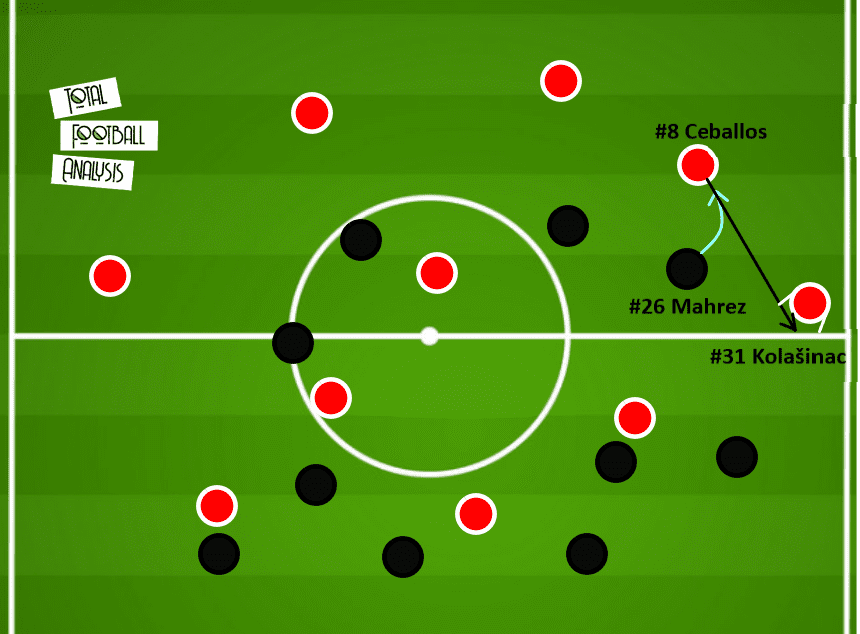
Final remarks
Pep believes formations are just phone numbers, but Lillo is a step further – even positions do not define any meanings. This game against Arsenal is good evidence of the above statements: with a clear set of principles of plays and a strong game plan, they don’t even need to stick to positions. Although this is already a very long piece, if we are dissecting to the finest details, there is much more to analyse, such as their rotations at flanks to generate superiorities.
Arteta’s position is more fragile after each game, including this one. The team was partly outplayed in different sections of the game, and some mistakes were catastrophic – Rúnarsson could have done better for the first three goals. They really need a win to regain confidence and go on again, but the performance was not good enough.





Comments